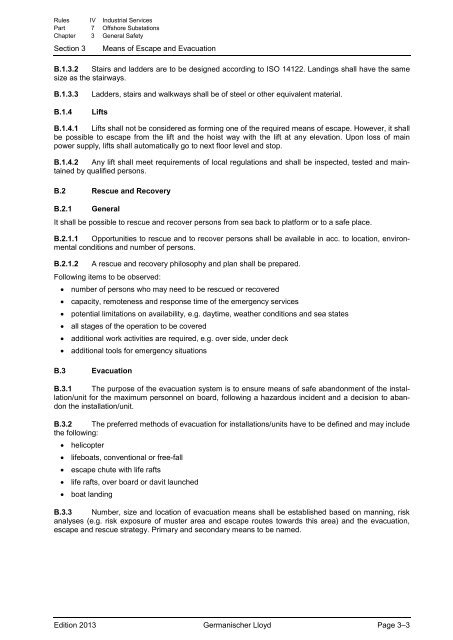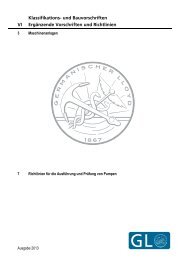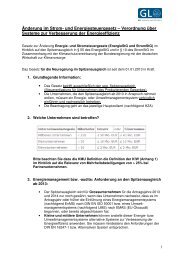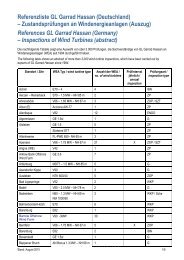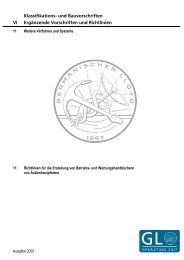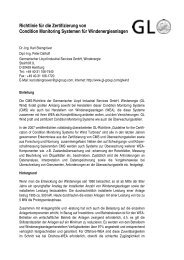(IV-7-3) General Safety
(IV-7-3) General Safety
(IV-7-3) General Safety
Create successful ePaper yourself
Turn your PDF publications into a flip-book with our unique Google optimized e-Paper software.
Rules <strong>IV</strong> Industrial Services<br />
Part 7 Offshore Substations<br />
Chapter 3 <strong>General</strong> <strong>Safety</strong><br />
Section 3<br />
Means of Escape and Evacuation<br />
B.1.3.2 Stairs and ladders are to be designed according to ISO 14122. Landings shall have the same<br />
size as the stairways.<br />
B.1.3.3<br />
B.1.4<br />
Ladders, stairs and walkways shall be of steel or other equivalent material.<br />
Lifts<br />
B.1.4.1 Lifts shall not be considered as forming one of the required means of escape. However, it shall<br />
be possible to escape from the lift and the hoist way with the lift at any elevation. Upon loss of main<br />
power supply, lifts shall automatically go to next floor level and stop.<br />
B.1.4.2 Any lift shall meet requirements of local regulations and shall be inspected, tested and maintained<br />
by qualified persons.<br />
B.2 Rescue and Recovery<br />
B.2.1 <strong>General</strong><br />
It shall be possible to rescue and recover persons from sea back to platform or to a safe place.<br />
B.2.1.1 Opportunities to rescue and to recover persons shall be available in acc. to location, environmental<br />
conditions and number of persons.<br />
B.2.1.2 A rescue and recovery philosophy and plan shall be prepared.<br />
Following items to be observed:<br />
• number of persons who may need to be rescued or recovered<br />
• capacity, remoteness and response time of the emergency services<br />
• potential limitations on availability, e.g. daytime, weather conditions and sea states<br />
• all stages of the operation to be covered<br />
• additional work activities are required, e.g. over side, under deck<br />
• additional tools for emergency situations<br />
B.3 Evacuation<br />
B.3.1 The purpose of the evacuation system is to ensure means of safe abandonment of the installation/unit<br />
for the maximum personnel on board, following a hazardous incident and a decision to abandon<br />
the installation/unit.<br />
B.3.2 The preferred methods of evacuation for installations/units have to be defined and may include<br />
the following:<br />
• helicopter<br />
• lifeboats, conventional or free-fall<br />
• escape chute with life rafts<br />
• life rafts, over board or davit launched<br />
• boat landing<br />
B.3.3 Number, size and location of evacuation means shall be established based on manning, risk<br />
analyses (e.g. risk exposure of muster area and escape routes towards this area) and the evacuation,<br />
escape and rescue strategy. Primary and secondary means to be named.<br />
Edition 2013 Germanischer Lloyd Page 3–3


